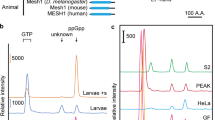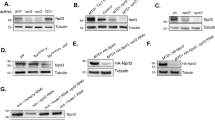Abstract
In nutrient-starved bacteria, RelA and SpoT proteins have key roles in reducing cell growth and overcoming stresses. Here we identify functional SpoT orthologs in metazoa (named Mesh1, encoded by HDDC3 in human and Q9VAM9 in Drosophila melanogaster) and reveal their structures and functions. Like the bacterial enzyme, Mesh1 proteins contain an active site for ppGpp hydrolysis and a conserved His-Asp–box motif for Mn2+ binding. Consistent with these structural data, Mesh1 efficiently catalyzes hydrolysis of guanosine 3′,5′-diphosphate (ppGpp) both in vitro and in vivo. Mesh1 also suppresses SpoT-deficient lethality and RelA-induced delayed cell growth in bacteria. Notably, deletion of Mesh1 (Q9VAM9) in Drosophila induces retarded body growth and impaired starvation resistance. Microarray analyses reveal that the amino acid–starved Mesh1 null mutant has highly downregulated DNA and protein synthesis–related genes and upregulated stress-responsible genes. These data suggest that metazoan SpoT orthologs have an evolutionarily conserved function in starvation responses.
This is a preview of subscription content, access via your institution
Access options
Subscribe to this journal
Receive 12 print issues and online access
$189.00 per year
only $15.75 per issue
Buy this article
- Purchase on Springer Link
- Instant access to full article PDF
Prices may be subject to local taxes which are calculated during checkout




Similar content being viewed by others
References
Cashel, M. & Gallant, J. Two compounds implicated in the function of the RC gene of Escherichia coli. Nature 221, 838–841 (1969).
Cashel, M., Gentry, D.R., Hernandez, V.J. & Vinella, D. The stringent response. in Escherichia coli and Salmonella typhimurium. Cellular and Molecular Biology 1458–1496: (ASM Press, Washington, DC, 1996).
Potrykus, K. & Cashel, M. (p)ppGpp: still magical? Annu. Rev. Microbiol. 62, 35–51 (2008).
Haseltine, W.A. & Block, R. Synthesis of guanosine tetra- and pentaphosphate requires the presence of a codon-specific, uncharged transfer ribonucleic acid in the acceptor site of ribosomes. Proc. Natl. Acad. Sci. USA 70, 1564–1568 (1973).
Battesti, A. & Bouveret, E. Acyl carrier protein/SpoT interaction, the switch linking SpoT-dependent stress response to fatty acid metabolism. Mol. Microbiol. 62, 1048–1063 (2006).
Metzger, S. et al. Characterization of the relA1 mutation and a comparison of relA1 with new relA null alleles in Escherichia coli. J. Biol. Chem. 264, 21146–21152 (1989).
Xiao, H. et al. Residual guanosine 3′,5′-bispyrophosphate synthetic activity of relA null mutants can be eliminated by spoT null mutations. J. Biol. Chem. 266, 5980–5990 (1991).
Laffler, T. & Gallant, J.A. Stringent control of protein synthesis in E. coli. Cell 3, 47–49 (1974).
Schreiber, G. et al. Overexpression of the relA gene in Escherichia coli. J. Biol. Chem. 266, 3760–3767 (1991).
Kasai, K. et al. A RelA-SpoT homolog (Cr-RSH) identified in Chlamydomonas reinhardtii generates stringent factor in vivo and localizes to chloroplasts in vitro. Nucleic Acids Res. 30, 4985–4992 (2002).
Givens, R.M. et al. Inducible expression, enzymatic activity, and origin of higher plant homologues of bacterial RelA/SpoT stress proteins in Nicotiana tabacum. J. Biol. Chem. 279, 7495–7504 (2004).
van der Biezen, E.A., Sun, J., Coleman, M.J., Bibb, M.J. & Jones, J.D. Arabidopsis RelA/SpoT homologs implicate (p)ppGpp in plant signaling. Proc. Natl. Acad. Sci. USA 97, 3747–3752 (2000).
Masuda, S. et al. The bacterial stringent response, conserved in chloroplasts, controls plant fertilization. Plant Cell Physiol. 49, 135–141 (2008).
Mizusawa, K., Masuda, S. & Ohta, H. Expression profiling of four RelA/SpoT-like proteins, homologues of bacterial stringent factors, in Arabidopsis thaliana. Planta 228, 553–562 (2008).
Tozawa, Y. et al. Calcium-activated (p)ppGpp synthetase in chloroplasts of land plants. J. Biol. Chem. 282, 35536–35545 (2007).
Braeken, K. et al. New horizons for (p)ppGpp in bacterial and plant physiology. Trends Microbiol. 14, 45–54 (2006).
Silverman, R.H. & Atherly, A.G. The search for guanosine tetraphosphate (ppGpp) and other unusual nucleotides in eucaryotes. Microbiol. Rev. 43, 27–41 (1979).
Mittenhuber, G. Comparative genomics and evolution of genes encoding bacterial (p)ppGpp synthetases/hydrolases (the Rel, RelA and SpoT proteins). J. Mol. Microbiol. Biotechnol. 3, 585–600 (2001).
Aravind, L. & Koonin, E.V. The HD domain defines a new superfamily of metal-dependent phosphohydrolases. Trends Biochem. Sci. 23, 469–472 (1998).
Rhee, H.W. et al. Selective fluorescent chemosensor for the bacterial alarmone (p)ppGpp. J. Am. Chem. Soc. 130, 784–785 (2008).
Gallant, J., Margason, G. & Finch, B. On the turnover of ppGpp in Escherichia coli. J. Biol. Chem. 247, 6055–6058 (1972).
Takahashi, K., Kasai, K. & Ochi, K. Identification of the bacterial alarmone guanosine 5′-diphosphate 3′-diphosphate (ppGpp) in plants. Proc. Natl. Acad. Sci. USA 101, 4320–4324 (2004).
Guranowski, A. Metabolism of diadenosine tetraphosphate (Ap4A) and related nucleotides in plants; review with historical and general perspective. Front. Biosci. 9, 1398–1411 (2004).
Holm, L. & Sander, C. Protein structure comparison by alignment of distance matrices. J. Mol. Biol. 233, 123–138 (1993).
Zimmerman, M.D., Proudfoot, M., Yakunin, A. & Minor, W. Structural insight into the mechanism of substrate specificity and catalytic activity of an HD-domain phosphohydrolase: the 5′-deoxyribonucleotidase YfbR from Escherichia coli. J. Mol. Biol. 378, 215–226 (2008).
Xu, R.X. et al. Atomic structure of PDE4: insights into phosphodiesterase mechanism and specificity. Science 288, 1822–1825 (2000).
Mechold, U. et al. Functional analysis of a relA/spoT gene homolog from Streptococcus equisimilis. J. Bacteriol. 178, 1401–1411 (1996).
Hogg, T. et al. Conformational antagonism between opposing active sites in a bifunctional RelA/SpoT homolog modulates (p)ppGpp metabolism during the stringent response. Cell 117, 57–68 (2004).
Avarbock, D., Avarbock, A. & Rubin, H. Differential regulation of opposing RelMtb activities by the aminoacylation state of a tRNA.ribosome.mRNA.RelMtb complex. Biochemistry 39, 11640–11648 (2000).
Wehmeier, L. et al. A Corynebacterium glutamicum mutant with a defined deletion within the rplK gene is impaired in (p)ppGpp accumulation upon amino acid starvation. Microbiology 147, 691–700 (2001).
Song, M. et al. ppGpp-dependent stationary phase induction of genes on Salmonella pathogenicity island 1. J. Biol. Chem. 279, 34183–34190 (2004).
Artsimovitch, I. et al. Structural basis for transcription regulation by alarmone ppGpp. Cell 117, 299–310 (2004).
Paul, B.J., Ross, W., Gaal, T. & Gourse, R.L. rRNA transcription in Escherichia coli. Annu. Rev. Genet. 38, 749–770 (2004).
Magnusson, L.U., Farewell, A. & Nyström, T. ppGpp: a global regulator in Escherichia coli. Trends Microbiol. 13, 236–242 (2005).
Durfee, T. et al. Transcription profiling of the stringent response in Escherichia coli. J. Bacteriol. 190, 1084–1096 (2008).
Eymann, C., Homuth, G., Scharf, C. & Hecker, M. Bacillus subtilis functional genomics: global characterization of the stringent response by proteome and transcriptome analysis. J. Bacteriol. 184, 2500–2520 (2002).
Britton, J.S. & Edgar, B.A. Environmental control of the cell cycle in Drosophila: nutrition activates mitotic and endoreplicative cells by distinct mechanisms. Development 125, 2149–2158 (1998).
Beissbarth, T. & Speed, T.P. GOstat: find statistically overrepresented Gene Ontologies within a group of genes. Bioinformatics 20, 1464–1465 (2004).
Palanker, L., Tennessen, J.M., Lam, G. & Thummel, C.S. Drosophila HNF4 regulates lipid mobilization and beta-oxidation. Cell Metab. 9, 228–239 (2009).
Zinke, I. et al. Nutrient control of gene expression in Drosophila: microarray analysis of starvation and sugar-dependent response. EMBO J. 21, 6162–6173 (2002).
Jones, G.H. & Bibb, M.J. Guanosine pentaphosphate synthetase from Streptomyces antibioticus is also a polynucleotide phosphorylase. J. Bacteriol. 178, 4281–4288 (1996).
Hoyt, S. & Jones, G.H. relA is required for actinomycin production in Streptomyces antibioticus. J. Bacteriol. 181, 3824–3829 (1999).
Mukai, J., Hirashima, A. & Mikuniya, T. Nucleotide 2′,3′-cyclic monophosphokinase from actinomycetes. Nucleic Acids Symp. Ser. 22, 89–90 (1980).
Muta, S. et al. Streptomyces ATP nucleotide 3′-pyrophosphokinase and its gene. Nucleic Acids Symp. Ser. 27, 165–166 (1992).
Sawaya, M.R. et al. Crystal structures of human DNA polymerase beta complexed with gapped and nicked DNA: evidence for an induced fit mechanism. Biochemistry 36, 11205–11215 (1997).
Ochi, K., Kandala, J.C. & Freese, E. Initiation of Bacillus subtilis sporulation by the stringent response to partial amino acid deprivation. J. Biol. Chem. 256, 6866–6875 (1981).
Ochi, K. Streptomyces relC mutants with an altered ribosomal protein ST-L11 and genetic analysis of a Streptomyces griseus relC mutant. J. Bacteriol. 172, 4008–4016 (1990).
Rhaese, H.J. Studies on the control of development synthesis of regulatory nucleotides, HPN and MS, in mammalian cells in tissue cultures. FEBS Lett. 53, 113–118 (1975).
Thammana, P., Buerk, R.R. & Gordon, J. Absence of ppGpp production in synchronised Balb/C mouse 3T3 cells on isoleucine starvation. FEBS Lett. 68, 187–190 (1976).
Park, J. et al. Mitochondrial dysfunction in Drosophila PINK1 mutants is complemented by parkin. Nature 441, 1157–1161 (2006).
Gassner, N.C. & Matthews, B.W. Use of differentially substituted selenomethionine proteins in X-ray structure determination. Acta Crystallogr. D Biol. Crystallogr. 55, 1967–1970 (1999).
Ohmura, T., Ueda, T., Hashimoto, Y. & Imoto, T. Tolerance of point substitution of methionine for isoleucine in hen egg white lysozyme. Protein Eng. 14, 421–425 (2001).
Terwilliger, T.C. & Berendzen, J. Automated MAD and MIR structure solution. Acta Crystallogr. D Biol. Crystallogr. 55, 849–861 (1999).
Terwilliger, T.C. Maximum-likelihood density modification. Acta Crystallogr. D Biol. Crystallogr. 56, 965–972 (2000).
Emsley, P. & Cowtan, K. Coot: model-building tools for molecular graphics. Acta Crystallogr. D Biol. Crystallogr. 60, 2126–2132 (2004).
Murshudov, G.N., Vagin, A.A. & Dodson, E.J. Refinement of macromolecular structures by the maximum-likelihood method. Acta Crystallogr. D Biol. Crystallogr. 53, 240–255 (1997).
Brünger, A.T. et al. Crystallography & NMR system: a new software suite for macromolecular structure determination. Acta Crystallogr. D Biol. Crystallogr. 54, 905–921 (1998).
Collaborative Computational Project, Number 4. The CCP4 suite: programs for protein crystallography. Acta Crystallogr. D Biol. Crystallogr. 50, 760–763 (1994).
Laskowski, R.A., MacArthur, M.W., Moss, D.S. & Thornton, J.M. PROCHECK: a program to check the stereochemical quality of protein structures. J. Appl. Cryst. 26, 283–291 (1993).
Acknowledgements
This research was supported by grants from the Korean National Creative Research Initiatives Program (2010-0018291) to J.C. and from the NMR Research Program of Korea Basic Science Institute to Y.H.J. G.L. was supported by the Priority Research Centers Program through the National Research Foundation of Korea, funded by the Ministry of Education, Science and Technology (2008-005-J00203). Y.K. and B.Y.K. were supported by World Class Institute Program of the National Research Foundation of Korea, funded by the Ministry of Education, Science and Technology. Wild-type (CF1648) and ΔrelA ΔspoT (CF1693) E. coli were kindly provided by M. Cashel (US National Institutes of Health).
Author information
Authors and Affiliations
Contributions
D.S. determined the structures and performed HPLC and MS analyses. G.L. and J.H.L. performed Drosophila and bacteria experiments. H.-Y.K. and K.-J.K. helped to determine the structures. H.-W.R. and J.-I.H. prepared PyDPA analyses. S.-Y.P. analyzed nucleotides from larval extracts. Y.K. performed mammalian cell culture experiments. All authors, including B.Y.K., C.P., H.E.C. and J.H.K. discussed the experimental results and the text of the manuscript. D.S., G.L., J.H.L., Y.H.J. and J.C. prepared the manuscript. J.C. and Y.H.J. developed the original research idea and supervised the research project.
Corresponding authors
Ethics declarations
Competing interests
The authors declare no competing financial interests.
Supplementary information
Supplementary Text and Figures
Supplementary Figures 1–6, Supplementary Tables 1–2 and Supplementary Methods (PDF 827 kb)
Supplementary Table 3
Differentially expressed genes in response to amino acid starvation in wild-type and Mesh1 null mutant flies. (a–c) GO stat analysis was performed for the downregulated and upregulated genes in response to amino acid starvation in dMesh1 null mutant (b,c) or wild-type flies (a). The affected GO categories and the P value of match are indicated. Gene name and the fold change of each gene included in each GO category are indicated. (XLS 71 kb)
Rights and permissions
About this article
Cite this article
Sun, D., Lee, G., Lee, J. et al. A metazoan ortholog of SpoT hydrolyzes ppGpp and functions in starvation responses. Nat Struct Mol Biol 17, 1188–1194 (2010). https://doi.org/10.1038/nsmb.1906
Received:
Accepted:
Published:
Issue Date:
DOI: https://doi.org/10.1038/nsmb.1906
This article is cited by
-
MESH1 knockdown triggers proliferation arrest through TAZ repression
Cell Death & Disease (2022)
-
The stringent response and physiological roles of (pp)pGpp in bacteria
Nature Reviews Microbiology (2021)
-
The regulation of ferroptosis by MESH1 through the activation of the integrative stress response
Cell Death & Disease (2021)
-
ppGpp functions as an alarmone in metazoa
Communications Biology (2020)
-
MESH1 is a cytosolic NADPH phosphatase that regulates ferroptosis
Nature Metabolism (2020)



